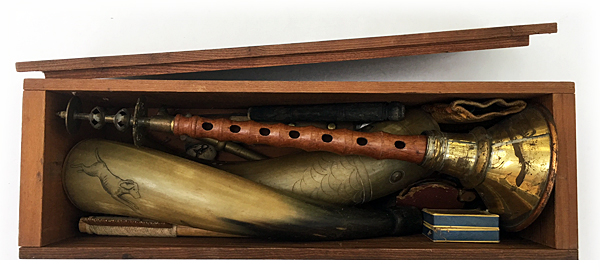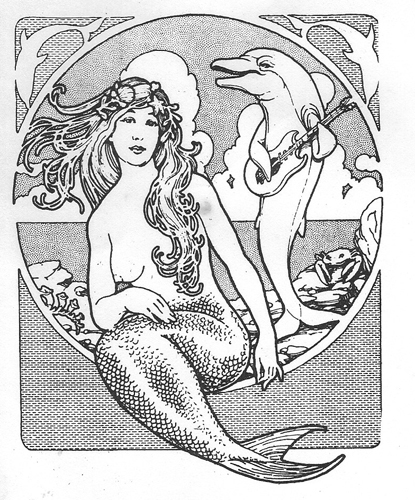The Idea Institute was a presentation of the University of California Extension, and reflected how deeply new ideas about art and communication were overtaking modern society in the late 1960s. In addition to Kurt von Meier, the speakers included Mel Blanc (the voice of Bugs Bunny), Fordham University Communication Arts Professor Edmund Carpenter, Sociology Professor Lewis Yablonsky and others. As usual, Kurt made notes prior to his remarks; to see them, read more.
A Kvon Meier Treasure Box
Kurt was a collector. He'd find objects and relics, then place them in containers and boxes which he'd squirrel away in closets, cabinets and hiding places known only to him. From time to time he'd pull one out and talk about each item so contained. Some treasure boxes were filled with Native American artifacts, others with bones and ivory. Every item had a story. This box held horns, mostly. For a closer look at the contents, read more.
November 24, 1963
Kurt clipped articles from newspapers and magazines like crazy, but rarely kept an entire page let alone a section of the local paper. The exception is this, the front section of the San Francisco Examiner from 1963. Of note is the slogan in the paper's masthead: "America First."
Two-Word Phrases
This discolored, rumpled sheet of paper fell out of one of Kurt's archived file folders. The chances are good that it was compiled while Kurt and his friend Carl Belz were working on their History of Rock and Roll book project in the early 60s; "Itsy-Bitsy"/"Teeny-Weenie" are the tip off. Or maybe not.
Vajra Mukut - The Ceremony of the Black Crown
"The Ceremony of the Black Crown or Vajra Mukut, which His Holiness alone can perform, transmits the energy and intelligence of the awakened state of mind." So reads a sentence from the program booklet provided for attendees for an empowerment ritual performed by His Holiness, the XVI Gyalwa Karmapa. Kurt von Mieir would not have missed it for the world, and along with a retinue of Diamond Sufi Ranch family members joined the large crowd at Fort Mason on October 13, 1974.
Intermedia '68
The late sixties were a period of ferment in the arts, and the notion of intermedia--the mix of art, technology, kinetic environments, mixed-media, dance and more--became popular as conventional art boundaries began to dissolve. The idea of "happenings" was hot, and Kurt "dug the scene". Among his archives are materials related to various intermedia events and organizations, such as E.A.T. and USCO. Robert Rauschenberg was in the forefront of such movements, and embraced such collaborations. Below is a flyer about an event, Intermedia '68, held in New York, managed by John Brockman Associates, who later acted as a book agent for Kurt. (Photo: Carolee Schneemann performing an enviromental theatre piece).
Who is G. Spencer Brown and where is that marvelous music coming from?
In 1973 Kurt's friend and collaborator Cliff Barney penned this article which appeared in the Pacific Sun newspaper. As Barney tells it, "There really was a conference at Big Sur at which G. Spencer Brown discussed his calculus with a group of far-out scientists." By conference, he means the AUM Conference at Esalen, and by far-out he means an assortment remarkable individuals exploring the cutting edge of human consciousness and culture, like Alan Watts, Ram Dass, John Lilly, Heinz von Foerster, Kurt von Meier and more. The transcripts of the AUM Conference at Esalen can be found here.
On Audio: Warhol Day at UCLA- 1966 with Lou Reed and Gerard Malanga
Left to right: Nico, Andy Warhol, Gerard Malanga, Lou Reed and John Cale (far right)
Kurt thought Andy Warhol was masterful, and after visiting Andy's "factory" in New York had written a lengthy article about Andy and Warhol's "scene" for Art International magazine in 1966. He also invited Andy to present a guest lecture to Kurt's undergraduate art class, and this audio recording captured that event. Andy, typically, did not say anything, but poet Gerard Malanga plus Lou Reed and John Cale (of the Velvet Underground) read poetry to the class, which was then followed by a screening of a Warhol film. The audio runs close to an hour and takes a minute to load.
A Cantata for the Dead Sheep of Utah
Folded into quarters and tucked inside one of Kurt's Manila folders, this creatively arresting document was found. A typewritten assemblage of news reports and graphics tell the story of the sheep wretchedly poisoned in Utah by U.S. government nerve gas tests. Signed by George Ashley and dated August, 1968, it meant enough to Kurt to preserve. And now all may read the tale.
Russell's Other Dream
Kurt respected Bertrand Russell (pictured), the British polymath who --philosopher, author, social activist, devoted pacifist--also had a passion for mathematics.
This typewritten sheet was found within what Kurt liked to call his half-vast archives.
Only Two Can Play This Game
In addition to being a visionary mathematician, G. Spencer Brown was a poet, and his small book Only Two Can Play This Game was as important to Kurt von Meier as Brown's book Laws of Form. Kurt regularly distributed this excerpt from the "notes" section of Brown's poetry book to his students, which Brown had published under his pseudonym James Keys. The excerpt neatly encapsulates a number of topics of particular interest to Kurt, including The Void, Eternity, Unity, and Brown's mathematical model, the key unlocking the mystery of being.
The Heart Sutra
The Sutra of the Heart of Transcendent Knowledge--The Heart Sutra, as it is commonly known--is the most widely chanted Buddhist sutra, worldwide. A condensation of the very much longer Prajnaparamita Sutra of 8,000 lines, it is a pith Mahayana Buddhist teaching which includes the famously paradoxical phrase "form is emptiness, emptiness also is form." It was a favorite of Kurt's and often introduced to his classes during his 40 years of teaching. The full text is available.
Mary Jane Superweed's Herbal Aphrodisiacs - 1971
Kurt's interest in all things herbal and psychedelic was long-standing. This little booklet from 1971 was found among his archives.
INTRODUCTION: What is an aphrodisiac? Everybody talks about aphrodisiacs, but no one seems to know anything about them. Many so called "experts" insist that there is no such thing as an aphrodisiac. It is not surprising that only a few decades ago many of the same "experts" assured us that the idea of sexual pleasure and orgasm in the female was "totally absurd". Our own definition of aphrodisiac includes substances which do any one or several of the following things: Produce erections in the male, arouse sexual feeling by stimulation of the genitals or nervous system, increase sensual awareness, relax inhibitions, augment physical energy, strengthen the gonads or other glands involved in sex, improve sexual health, increase the production of semen, help conquer impotence and frigidity (bearing in mind that these maladies are frequently of psychological origin), overcome sexual exhaustion, and prevent premature ejaculation. (Copyright 1971 - Stone Kingdom Syndicate)
Duchamp Regular - Upper and Lower Case plus Readymades
Kurt was trained in typography and lithography during his two years stint in the U.S. Navy, and he never lost his appreciation of fonts and printing. Among his archives was found a type sheet sample of a font based on the handwriting of Marcel Duchamp, and a set of Duchamp "wingdings" modeled on his Readymade sculptures.
The Tibetan Alphabet
Kurt's great facility with language enabled him to master French, Spanish, Greek and German, and the capacity to learn the basics of Japanese, Persian and Tibetan. He was particularly focused on alphabets and mastering the strokes and accents of calligraphy.
The chart of the Tibetan Alphabet below (a system of writing developed to transmit the Dharma) was found among his archives, along with this printed image of Six-Armed Mahakala (painted by Cynthia Moku), a so-called wrathful deity counted among those in Vajrayana Buddhism designated as "Dharma Protectors."
John C. Lilly and Heinz von Foerster discuss inter-species communication
John C. Lilly (1915-2001) became well known for his study of dolphins and research into human/dolphin communication. Heinz von Foerster (1911-2002) was an Austrian-born scientist recognized as one of the pioneers in cybernetics and artificial intelligence. Both John and Heinz were friends of Kurt. This recording was made by Kurt in 1975 during a small conference about inter-species communication. It runs about 20 minutes, and takes a short while to load.
Hopi Teachings and Prophecy
In 1969, Kurt traveled several times to the southwest with his trusty Nagra tape recorder and met with a number of Hopi Elders, including Thomas Banyacya (pictured - 1910-1999). In subsequent years, Thomas was visited by the Dalai Lama, and addressed the United Nations in 1992. He worked tirelessly as a spokesperson for the Hopi ("People of Peace"). The first interview transcript below is of a discussion with Thomas Banyacya and another Tribal Elder named Ralph Selina.
Kurt's questions focus on Hopi philosophy, spiritual views, challenges facing them and their land (including mining operations by Peabody Coal), and the Hopi Prophecies. Notably, the recent reduction of the protected portion of Bear's Ears National Monument by the Trump Administration (2017) directly affects the Hopi homeland.
Kurt also separately interviewed a Hopi tribal member named White Bear; their discussion concerns the author Frank Waters, whose book Book of the Hopi was published in 1963. Their conversation then turns to rabbit hunting, the preparation and ingredients of traditional Hopi meals, and the preservation of Hopi teachings.
Finally, this article includes Hopi commentary selected by Kurt from the transcripts, which he included in his 350,000-word online book, With Hidden Noise.
Over several years, the tapes of these interviews were carefully transcribed by Kurt's students, but generally have been otherwise unavailable.
Chinese Anyone?
This caligraphy was jammed between other documents in a beaten-up manila folder in Kurt's archives but was untranslated. We asked for help, and Phil Shea responded: "I know some Japanese and this Chinese character is used also in Japanese. It means "way" and appears in words like 'calligraphy' (the way of writing), 'Judo' (the gentle way), and 'expressway'. However, using a little 'Google-dou' (the way of Google) I found this link to the use of the character in Taoism - which I think is the most appropriate in this case. Here's the article. There is also this, which is about the character itself, without any assumption of meaning."
Balkan Sobranie Cigarettes
It was always "the best" for Kurt, and for many years he exclusively smoked Balkan Sobranie Cigarettes (since 1879 made only with the topmost leaves of the Yenidje tobacco plant), often combining the tobacco with marijuana. Naturally, he saved all the empty tins, which over time filled large containers.
Read moreCultural Revolution and the Native American Spirit
In 1970 Kurt delivered a guest lecture at Monterey Peninsula College, receiving his customary publicity in the local newspaper. Gratefully, an audio tape of that lecture was among his boxed archives, and has been converted to digital format. Read more to examine the article printed in advance of his lecture and for a link to the digital audio file (MP3) of the lecture itself.
































